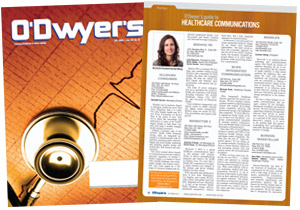|
|
Healthcare communicators regularly talk about change, both in terms of the continued evolution of our industry and our desires to shift the ways in which stakeholders think, feel and behave regarding our clients and their products. To this end, we’ve conceived fresh strategies, implemented innovative tactics, and developed and optimized new media.
So, I’m left with a nagging question: why is mundane writing still so prevalent in the industry?
I’m not talking about “bad” writing. This is not another diatribe against dangling modifiers and run-on sentences. I’m focused here on formulaic writing — writing that’s considered “safe” and that constitutes a significant percentage of the daily press releases run over any wire service by healthcare companies and their agencies.
|
|
Writing is the foundation of everything we do in public relations. At times, we interact directly with our audiences, but we usually reach our targets via the written word. Reporters are a major conduit to our valued stakeholders, and they vet our initiatives by the caliber, clarity and (we hope) excitement of our written materials. If the writing is predictable, we are more easily dismissed. But it’s not just reporter opinion about which we need to worry. Any of our audiences have their choice of information sources. If we bore them with our writing on a program website, they have several thousand alternatives.
Of course, we must be sensitive to regulations, but regulatory concerns don’t need to kill engaging content and style. There are hot buttons, of course, particularly those that trigger accusations about product claims. But after several years of experience, most of us have been conditioned to avoid select words (more, better, best), particularly without proper and well-supported scientific backing. But we’ve likewise been conditioned to supplant creative and energetic prose with dry, uninspired text.
So, what am I talking about specifically, and what do I propose? Let me illustrate the problem — and make some recommendations — using the staple of our industry: the press release.
The trouble with “saying”
Healthcare press releases have become virtually interchangeable. Although I have much to offer on a few major points, let me start with a smaller one, a point that focuses on a single word representative of the bigger problem. That word is “say” and its various tenses.
Since when did medical marketers and physicians get so uncomfortable with “remarking,” “noting,” “offering,” “explaining,” or other simple means of declaration? In their daily life, they’re no doubt perfectly fine with these actions. But in Press Release World, they only “say” — he said, she said, he says, she says. Or even worse, “he states,” “he stated”; it’s as though Cicero became a pharmaceutical spokesperson. The uniformity of these declarative verbs symbolizes the homogeneity of modern healthcare press releases. They often lack personality and character, and struggle to connect with audiences.
But it’s not just this single word that’s the problem. Let’s step back and look more broadly at the content of what spokespeople actually “say” to undermine the effectiveness of press releases.
Too “pleased,” too “proud”
I call the most common quote a “pleased/proud” (i.e., “We are pleased that our product was approved and proud to be working with all our valued partners who made it possible.”) Seriously, how many times have you read some version of this quote in a release? Yet, how often have you seen such a quote incorporated in an actual news story? I’ll bet your answers to the above are “every day” and “hardly ever,” respectively.
Our clients are intelligent and insightful experts with compelling opinions and engaging personalities. So why do their PR reps insert quotes so devoid of meaningful content and so stiffly written, presenting them as though they’ve been ironed into their suits? Being pleased and proud is a given, or we wouldn’t be issuing a release. It’s wasteful to expend valuable and limited space on statements that are redundant with the general spirit of external communications. Instead, our job as communicators is to help clients capitalize on quotes as opportunities to offer perceptive context and infuse stories with expressive energy.
Likewise, we want our client spokespeople to be considered key sources for relevant future developments. Reporters gravitate to experts on whom they can rely for colorful insights and sincere, well-informed opinions — neither of which require or presuppose recklessness. To secure a media following, one doesn’t need to offer the brand of “colorful” for which Donald Trump or Mark Cuban are known. Smart, insightful and articulate are enough, and we should measure every spokesperson quote by those criteria.
Put the story before the company
Quotes aren’t the only missed opportunities in press releases. Many releases lose reporters from the start with leads that are filled with “safe” qualifiers and distracting formalities. The standard healthcare release normally begins with: company positioning, including a descriptor involving a segment of the mission statement; mention of subsidiaries, partners or co-sponsors; and, depending on the featured development, a (typically lengthy) title of a study or educational initiative. Some additional verbiage is often necessary to address regulatory nuances, so it’s not uncommon for the actual news to begin around line six. This is not what we were taught in journalism school, but it has become a reality of the modern healthcare release.
To counteract this trend, PR writers must put the story before the company and its various agents and titles. Reporters — and most other audiences — care less about posturing and more about what is being done about issues larger than any of the players. But formalities such as names, titles, and qualifiers provide comfort and familiarity during the vulnerable act of releasing news. They just feel safer than leaping straight into it all. But it’s really only safer if NOT generating news is the goal.
Communication is an essential part of our healthcare system — informing physicians, patients, advocates and policymakers about developments that can change the treatment paradigm, impact costs to individuals and the system, and make better health more accessible to all. The innovation behind these changes is anything but safe — the news represents years and sometimes decades of passionate commitment to something daring and important. Next time you sit down to write a release, forget those safe and boring words, and make the prose worthy of the announcement.
* * *
Tom Jones is SVP and Health Practice Leader at Makovsky.




 Lo Isidro, senior director at Real Chemistry with more than a decade of strategic communications and PA experience, has joined Narrative Strategies.
Lo Isidro, senior director at Real Chemistry with more than a decade of strategic communications and PA experience, has joined Narrative Strategies. Nelson Fernandez, former North American chair of APCO Worldwide and managing director of Burson-Marsteller, has joined Volunteers in Medicine Berkshires as director of communications and PA.
Nelson Fernandez, former North American chair of APCO Worldwide and managing director of Burson-Marsteller, has joined Volunteers in Medicine Berkshires as director of communications and PA. Lilit Bargar, who was most recently an EVP in the healthcare practice at Weber Shandwick, comes on board at GCI Health as EVP, corporate practice lead.
Lilit Bargar, who was most recently an EVP in the healthcare practice at Weber Shandwick, comes on board at GCI Health as EVP, corporate practice lead.
 Five ways that successful thought leaders are made.
Five ways that successful thought leaders are made.


 Have a comment? Send it to
Have a comment? Send it to 
No comments have been submitted for this story yet.